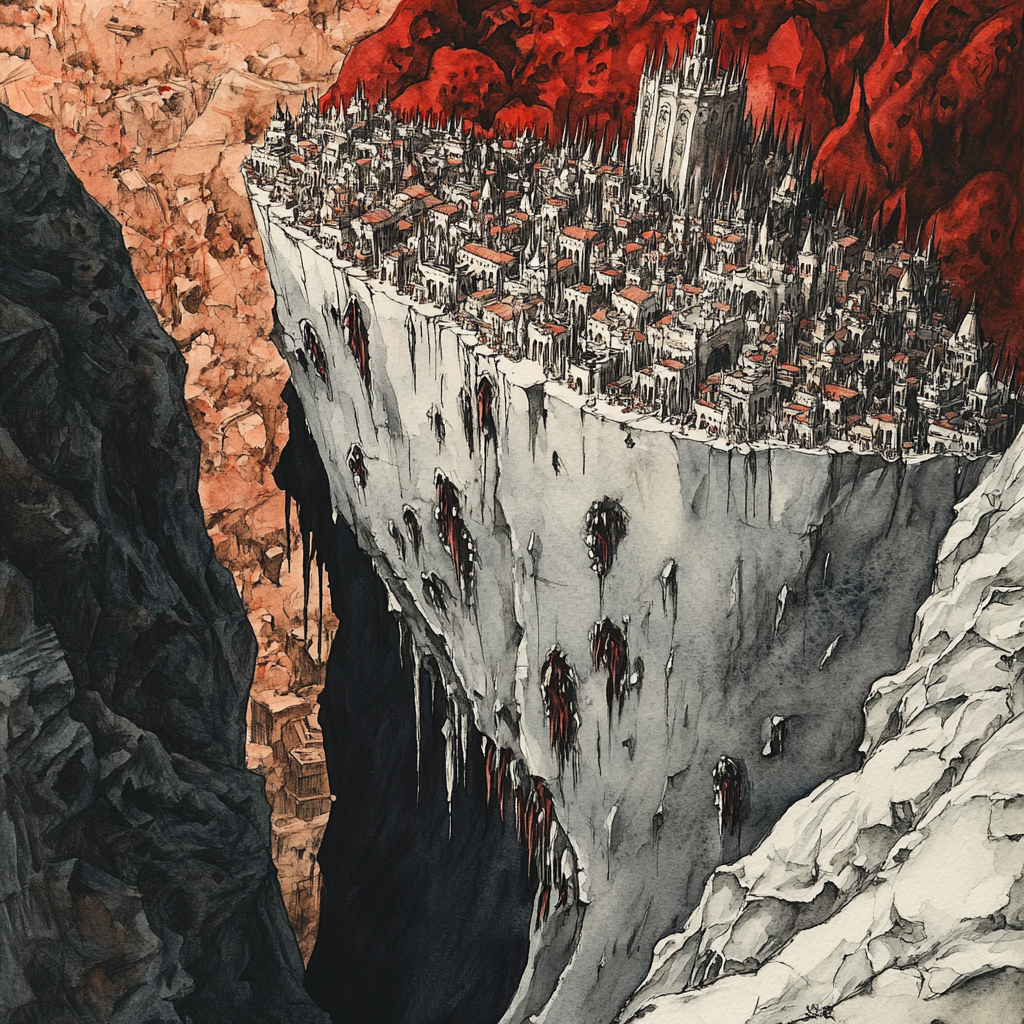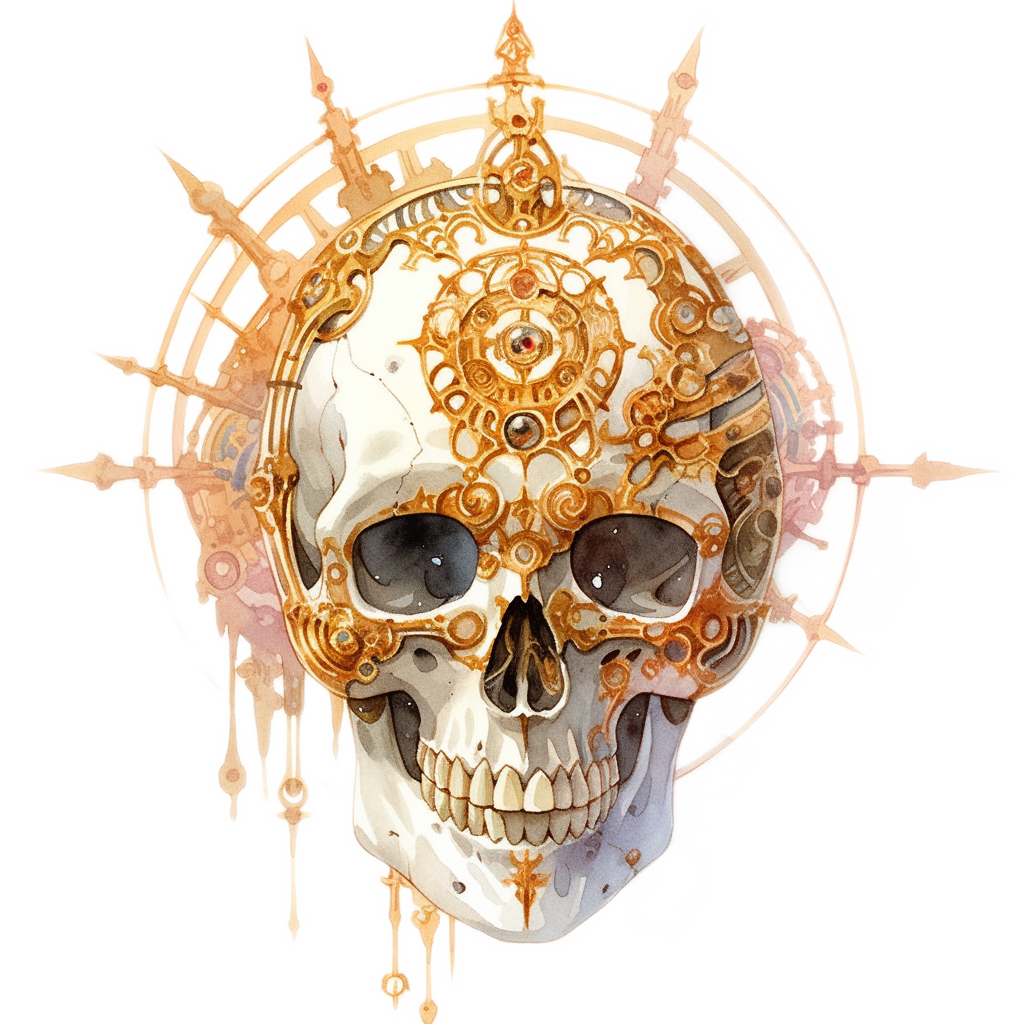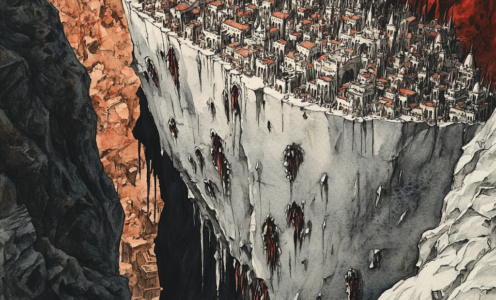Granite Spur

Location: Abyss / Grand Abyss / Upper Vorago of Precipit
Oh, so you want the dark of Granite Spur, do ya? Well, cutter, let me tell you the chant. The burg’s a proper barmy place, clinging to the edge of a colossal plateau like a drunkard hanging off a balcony. It’s the largest patch of flat ground in the Grand Abyss, sure, but don’t let that fool you into thinking it’s a safe place. Granite Spur’s got more shadows than light, and most of ‘em are hungry.
The story goes that Granite Spur started as a refuge for planewalkers too stubborn—or too clueless—to keep on climbing. Some berk found this plateau jutting out from the cliff face and figured it’d be a fine place to stop and rest. Trouble is, the Abyss don’t take kindly to settlers. Several of the first sods who tried to build there were crushed flat by falling boulders—or worse, by petitioners tumbling from above, screaming all the way down. But the survivors? They were hard as nails and twice as sharp. They built their burg anyway, hammering their homes into the rock with sheer bloody-mindedness, and erecting steel rooves to shield their burg from debris the Grand Abyss chucked their way.
These days Granite Spur’s a proper burg—if you can call a thousand buildings crammed onto a slab of stone ‘proper’. The place is so packed there ain’t an inch of space wasted; even the rooftops are used for markets or sleeping quarters. Some of the older buildings’ve got at tunnels leading deeper into the rock, but no one talks about what’s down there. Not unless they’ve had too much firewine and lost their sense anyhow.
The Economy: Blood and Stone
Granite Spur doesn’t have much in the way of natural resources—unless you count misery—but its economy somehow limps along. The locals dig into the plateau itself, pulling out rare Abyssal minerals used in dark rituals or fiendish weaponry. It’s dangerous work; one wrong swing of the pickaxe and you risk plummeting into the void below. Tanar’ri sometimes stop by to barter for (read: try and steal) supplies or information. The locals deal with them cautiously; the demons aren’t known for fair trades, but it’s a seller’s market and there are profts to be made. Granite Spur’s location similarly makes it a popular stop for cutters looking to rest their legs or find a guide to deeper Voragos. You’ll find plenty of touts and cony-catchers here, ready to peel any clueless berk who wanders in. Finally, if it’s bloodsport you’re after, there’s an arena carved into the rock where locals and visitors alike can test their mettle against captured qlippoth—or each other. The fights draw crowds from across the planes, and the betting keeps many a family fed.
Who Would Live Here?
Granite Spur’s full of hard cases—folk who’ve got nowhere else to go or who’ve been chased out of better places. To be honest, they’re not the sort you’d want to cross, cutter. You’ll find planar exiles who’ve crossed the wrong powers or factions and need somewhere to hide out. There are tough-as-nails miners who spend their days chipping away at the cliff face hoping for a lucky find to make them rich, although they’re just as likely to have sort and brutal lives. Long-time locals who know the surrounding Vorago like the back of their hand might offer to act as guides if they’re garnished well enough, though whether they’ll lead you true or sell you out to tanar’ri is another matter. These are the stubborn bloods who’ve carved out homes in the cliff face or built shanties atop the plateau. They know every crevice and secret of Granite Spur and the surrounding area, but they don’t share their knowledge lightly.
You can also find the occasional petitioner here, poor sods, trying to eke out some semblance of existence before they’re dragged off by tanar’ri. Thing is, the Abyss doesn’t like them to rest, and they tend to find themselves at the wrong end of bad luck if they hang about the burg—targeted by falling boulders and the like—which means the locals round up anyone they suspect is a petitioner and throw them off the edge of the plateau. Sounds cruel, does it? Welcome to the Abyss.
Finally, there are the scavengers, bestial sods who hide out in cliff-caverns surrounding the burg and sneak in under cover of darkness to pick through the remains of petitioners or demons that tumble from above, looking for anything valuable, or just a grim feast.
Granite Spur’s location makes it a hub for those brave or barmy enough to trade in the Abyss. Fiendish merchants stop by to barter goods, while local traders deal in everything from rare ores to stolen planar artifacts. The town’s markets are chaotic and cutthroat, but if you’re looking for something rare—or illegal—you’re likely to find it here. Watch your purse, and your back. The traders here will fleece you blind, or worse, if they think they can get away with it.
Dangers of Granite Spur
Aside from the obvious danger of falling, or being shoved, off the egde into the Abyss below, planewalkers would be advised to pay attention to the sky above them. The biggest danger here comes from above. Falling petitioners are one thing, but at least they have the decency to scream as they plummet. The blunders are not nearly so helpful; with the poor visitibility a berk is likely to get only a few seconds warning before being pounded by rocks at a terminal velocity [Standard Reflex save at DC30 for 10d6 damage]. Keep your eyes up if you like your skull head-shaped. The town’s factions are almost as dangerous as its terrain. There are no guilds here, Abyssal berks are far too chaotic for that sort of thing, but the result is an anarchic free-for-all. Traders vie for control of the markets using any kind of underhanded business tactics they can dream up. Miners fight over claims, and are known to sabotage one another on the job too. Getting caught in their crossfire is a quick way to end up dead—or worse.
Granite Spur? Yeah, I’ve been there—once was enough! The place is crawling with desperate sods who’d sell you out for a handful of jink or a scrap of food. The air stinks of sweat and despair, and every time I looked up I half-expected a boulder to come crashing down on my head. But I’ll tell ya this: you won’t find a better market this side of Pazunia.
Philosophy on the Edge
The residents of Granite Spur have developed some uniquely dark and fatalistic philosophies, shaped by their precarious existence on the edge of the Grand Abyss. Often referred to as The Creed of the Crumbling Edge, is a bleak yet strangely empowering blend of nihilism, entropy, and survivalist pragmatism. Unsurprsingly, membership of the Doomguard faction is commonplace here, but the locals of Granite Spur have their own flavour of thinking that is influenced by the atmosphere of the Grand Abyss, a sect called the Edgewalkers. While their beliefs may seem bleak, they also foster incredible resilience. The cutters of Granite Spur do not fear failure or death; they see these things as inevitable parts of existence.
The Abyss Takes All: At the heart of the creed is the belief that everything—life, stone, and even the multiverse itself—is destined to fall into chaos and dissolution. The Abyss, they say, is not just a place but the embodiment of an inexorable force: the inevitable pull toward destruction that no power can resist. The creed fosters a grim acceptance of death and decay as natural and unavoidable.
Hold Until You Fall: Despite their fatalism, the people of Granite Spur embrace a fierce determination to hold on for as long as they can. Life here is a constant struggle against the pull of the Abyss, and every day survived is considered a small victory against the uncaring multiverse. The motto Hold Until You Fall is a greeting, a rallying cry and a grim reminder that even defiance is fleeting. Berks here are far too self-centred to do anything as gauche as sharing, but similarly, hoarding is seen as futile in a world where everything eventually crumbles.
The Void Is Freedom: Paradoxically, many in Granite Spur view the Abyss not as the End but as a form of liberation. To them, the Void Below represents freedom from laws, powers, and the constraints of mortal existence. Believe it or not, some residents even romanticize falling into the Grand Abyss, believing it to be a return to pure chaos—a final escape from all their burdens.
What Is Built Must Break: The residents reject permanence as an illusion. Buildings crumble, alliances fracture, and lives end—it’s all part of the natural order. This philosophy drives their practical approach to life: they build only what is necessary to survive and waste no effort on embellishment or daft notions like legacy. When a building or tool becomes too old or damaged to use, it is ceremonially destroyed in a Breaking Ceremony rather than repaired. This act symbolizes acceptance of entropy and serves as a reminder that nothing lasts forever.
Life in Granite Spur
Every month or so, the town gathers for the Falling Feast, a grim festival where locals celebrate those who’ve been lost to the falling boulders or petitioners from above. And by celebrate I mean it in the most vindictive sense; cutters tell dark joke at the expense of the dead, haggle over their possessions, and share stories of how they won’t be missed. The festival is held beneath a canopy of magical cloth to shield participants from potential debris. Offerings of food, drink, and small trinkets are placed at the edge of the plateau and ceremonially dropped into the void as a (probably futile) gesture to appease the Abyss itself with a Void Tithe. Local superstition states that failing to participate invites bad luck for the next month.
If a respected cutter dies in Granite Spur, their body is not thrown off the edge but instead placed in a seated position at the edge of the plateau and turned to stone using captured cockatrice. These grim stone figures line the edges of Granite Spur like gargoyles, facing outward as if guarding against whatever horrors lurk beyond.
When the unlucky children of Granite Spur come of age, they undergo the Cliff Rite, a harrowing trial where they must climb down a short section of the cliff face without safety ropes and retrieve a crystal embedded in the rock. These prizes are then fashioned into charms, which are worn to protect against falling deaths. Many don’t survive this rite, but those who do are considered full members of the community and called Edgewalkers.
Source: Jon Winter-Holt


